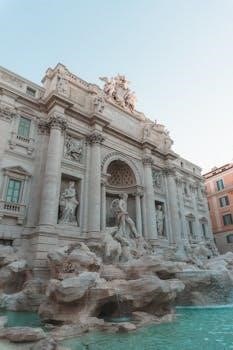Don Quixote PDF⁚ A Comprehensive Guide
Embark on a literary quest with our comprehensive guide to accessing “Don Quixote” in PDF format. Discover readily available versions of Miguel de Cervantes’ masterpiece. Uncover the enthralling story of the knight-errant and his squire. It is a classic tale available for digital download.
Welcome to the timeless world of “Don Quixote,” a novel that transcends generations. It is celebrated as the first modern novel. This literary treasure, penned by Miguel de Cervantes, invites readers into the heart of 16th-century Spain. It presents the adventures of Alonso Quijano.
Quijano transforms into the knight-errant Don Quixote. He is driven by an obsession with chivalrous ideals from the books he devours. Alongside his loyal squire, Sancho Panza, Don Quixote embarks on a series of adventures. The adventures blur the lines between reality and fantasy. Their journey is filled with comical misadventures.
Explore the themes of idealism versus realism and madness versus sanity. Delve into social commentary woven throughout the narrative. “Don Quixote” offers a profound reflection on human nature and society. It remains relevant and captivating; Accessing “Don Quixote” in PDF format allows readers to easily immerse themselves in this literary masterpiece.

The Author⁚ Miguel de Cervantes
Miguel de Cervantes Saavedra, a towering figure in Spanish literature, gifted the world “Don Quixote.” He was born in Alcalá de Henares, Spain, around 1547. Cervantes’ life was marked by adventure and hardship. He served as a soldier and was even held captive for five years. These experiences deeply influenced his writing.
Cervantes’ literary contributions extend beyond “Don Quixote.” He wrote plays, poems, and short stories. “Don Quixote” is considered his magnum opus. The book solidified his place as a literary genius. The novel’s innovative style and profound themes revolutionized literature.
Cervantes’ keen observations and his ability to blend humor with social commentary made him unique. He is one of the best writers. His influence continues to resonate with readers and writers today. Exploring “Don Quixote” provides insight into the mind of this extraordinary author. It allows one to appreciate his enduring legacy. Accessing his masterpiece in PDF format makes it accessible to modern audiences.

Synopsis of Don Quixote
“Don Quixote” follows Alonso Quijano, who renames himself Don Quixote. He is lost in chivalric romances. He sets out with Sancho Panza. They embark on comical adventures. He seeks to right wrongs in sixteenth-century Spain.
Don Quixote’s Obsession with Chivalry
Don Quixote’s character is built upon an intense and consuming obsession with the ideals of chivalry, derived from countless books he devoured. This fascination leads him to construct a reality where he is a knight-errant, tasked with defending the helpless and vanquishing the wicked, mirroring the heroic figures he so admires. His mind is so fully immersed in these romanticized tales. This creates a distorted perception of the world around him.
He perceives windmills as giants and inns as castles, driven by an unyielding desire to live out the grand adventures he has read about. This obsession, fueled by a longing for a bygone era of honor and valor, becomes the driving force behind his actions and shapes his interactions with the world, often leading to humorous and tragic consequences as he attempts to impose his idealized vision onto a reality that stubbornly refuses to conform.
The Adventures of Don Quixote and Sancho Panza
The adventures of Don Quixote and Sancho Panza form the heart of Cervantes’ novel, chronicling their travels through sixteenth-century Spain. Don Quixote, driven by his chivalric delusions, embarks on a series of quests, viewing ordinary events through the lens of knightly romance. Sancho Panza, his pragmatic squire, provides a grounded counterpoint to Don Quixote’s fantastical worldview.
Together, they encounter a diverse cast of characters and face numerous challenges, from tilting at windmills to battling imagined foes. Their journey is marked by humor, pathos, and moments of profound insight. Don Quixote’s unwavering idealism clashes with the harsh realities of the world. Sancho’s common sense offers a contrasting perspective. Their bond deepens through shared experiences, revealing the complexities of human nature and the enduring power of friendship amidst absurdity. The adventures demonstrate the contrast in personality.
Themes in Don Quixote
“Don Quixote” explores profound themes such as idealism versus realism, the blurred lines between madness and sanity, and incisive social commentary. These elements contribute to the novel’s enduring relevance and its status as a literary masterpiece across time.
Idealism vs. Realism
“Don Quixote” masterfully contrasts idealism and realism through the perspectives of Don Quixote and Sancho Panza. Quixote embodies idealism, driven by chivalric romances, and seeking to impose his romanticized worldview on reality. He perceives windmills as giants and seeks adventure where it doesn’t exist.
Sancho Panza, in stark contrast, represents realism. He is grounded in the practicalities of life, focused on survival and tangible rewards. He sees the world as it is, often clashing with Quixote’s fantastical interpretations.
The interplay between these opposing viewpoints highlights the challenges of living in a world that rarely aligns with our ideals. Cervantes explores the consequences of both extremes⁚ Quixote’s idealism leads to delusion and suffering, while Sancho’s realism may lack the inspiration and moral compass necessary for meaningful existence. The novel suggests a nuanced balance between these forces.
Madness and Sanity
“Don Quixote” explores the fine line between madness and sanity, prompting readers to question societal norms. Don Quixote’s obsession with chivalric romances leads to a perceived madness. He blurs the lines between fantasy and reality, engaging in fantastical adventures based on his delusions.
However, Cervantes cleverly portrays Quixote’s madness as a form of heightened idealism. His delusions, though irrational, are fueled by a desire for justice and a belief in a higher purpose. This raises the question of whether Quixote’s madness is merely a rejection of a flawed reality.
Conversely, the “sanity” of the other characters is often portrayed as a form of complacency or self-interest. They accept the world as it is, without questioning its injustices or seeking to improve it. Cervantes challenges readers to consider whether true sanity lies in conforming to societal expectations or in pursuing one’s ideals, even if it means being perceived as mad.
Social Commentary
“Don Quixote” serves as a sharp social commentary on 17th-century Spanish society. Cervantes critiques the decline of the aristocracy and the rise of materialism. Don Quixote’s anachronistic chivalry clashes with the pragmatic values of the time. This highlights the absurdity of clinging to outdated ideals in a changing world.
The novel also satirizes the literary conventions of the era, particularly the popular romances of chivalry. Cervantes exposes the unrealistic and often ridiculous nature of these tales. He contrasts them with the harsh realities of everyday life. The adventures of Don Quixote, though comical, reveal the social inequalities and injustices prevalent in Spanish society.
Furthermore, the relationship between Don Quixote and Sancho Panza reflects the social hierarchy of the time. Quixote, the nobleman, relies on Sancho, the peasant, to navigate the world. Their interactions highlight the tensions and dependencies between different social classes. The novel ultimately offers a nuanced critique of societal norms and power structures.

Adaptations of Don Quixote
“Don Quixote” has inspired countless adaptations across various media. These adaptations, including films and theatrical productions, demonstrate the enduring appeal. The timeless themes ensure the story continues to resonate with audiences worldwide. It is a testament to its legacy.
Film Adaptations
The enduring story of “Don Quixote” has found its way onto the silver screen in numerous film adaptations, each offering a unique interpretation of Cervantes’ iconic novel. From classic Hollywood productions to contemporary cinematic visions, filmmakers have embraced the challenge of bringing the adventures of Don Quixote and Sancho Panza to life.
These film adaptations often explore the themes of idealism versus realism, madness and sanity, and social commentary. The visual medium allows for a captivating portrayal of Don Quixote’s fantastical world. It is a world where windmills transform into giants and ordinary inns become majestic castles.
Notable film adaptations include both direct retellings of the novel and more loosely inspired works that capture the spirit of the original story. These films showcase the comedic and tragic elements of Don Quixote’s journey. They also highlight the complex relationship between the delusional knight and his pragmatic squire.
Through film, “Don Quixote” continues to captivate audiences with its timeless themes and memorable characters.
Theatrical Productions (Man of La Mancha)
Among the many adaptations inspired by Cervantes’ “Don Quixote,” the musical “Man of La Mancha” stands out as a particularly beloved and enduring theatrical production. First premiering on Broadway in 1965, this musical reimagining of the classic tale has captivated audiences worldwide with its powerful story, memorable songs, and exploration of profound themes.
“Man of La Mancha” tells the story of Miguel de Cervantes himself, imprisoned during the Spanish Inquisition. He stages a play for his fellow inmates, transforming himself into Don Quixote. Through this play-within-a-play, Cervantes explores the transformative power of imagination, the pursuit of impossible dreams, and the importance of maintaining hope in the face of adversity.
The musical features iconic songs such as “The Impossible Dream,” which encapsulates the spirit of Don Quixote’s unwavering idealism. “Man of La Mancha” is a testament to the enduring legacy of Cervantes’ masterpiece and its ability to inspire audiences across generations.
Numerous revivals and productions continue to grace stages around the globe.
Translations and Editions
The enduring popularity of “Don Quixote” has resulted in countless translations and editions, making it accessible to readers across the globe. The original Spanish text has been interpreted and adapted into numerous languages, each offering a unique perspective on Cervantes’ masterpiece.
Translators face the challenge of capturing the nuances of Cervantes’ language, including his wit, satire, and social commentary. Some translations prioritize accuracy, while others emphasize readability and contemporary language. The choice of translation can significantly impact the reader’s experience, highlighting different aspects of the novel.
Editions of “Don Quixote” also vary widely, ranging from scholarly editions with extensive annotations to abridged versions for younger readers. Some editions include illustrations, essays, and critical analyses, providing additional context and insights into the novel.
Notable translations include those by Samuel Putnam and John Ormsby, each offering a distinct interpretation of Cervantes’ work. Readers can explore the different translations and editions to find the one that best suits their preferences and reading goals. Modern Library edition presents the acclaimed Samuel Putnam translation of the epic tale.

Don Quixote as the First Modern Novel
“Don Quixote” is widely regarded as the first modern novel, marking a significant departure from traditional romance and epic narratives. Published in two parts (1605 and 1615), Cervantes’ work introduced innovative narrative techniques and explored complex themes that resonate with modern readers.
One of the key features of “Don Quixote” is its realism. Cervantes grounded his story in the everyday world, depicting the lives and customs of ordinary people in 16th-century Spain. This focus on realism contrasted sharply with the idealized settings and characters of chivalric romances.
The novel also introduced psychological depth and complexity to its characters. Don Quixote is not simply a caricature but a fully realized individual with his own dreams, delusions, and contradictions. Sancho Panza, his pragmatic squire, provides a contrasting perspective, grounding Don Quixote’s idealism in reality.
“Don Quixote” also pioneered the use of metafiction, drawing attention to the nature of storytelling itself. Cervantes frequently interrupts the narrative to comment on his own writing process, blurring the line between fiction and reality. These elements contributed to its status as the first modern novel.
Legacy and Influence of Don Quixote
“Don Quixote” has had a profound and lasting legacy on literature, art, and culture, inspiring countless writers, artists, and thinkers. Considered one of the greatest works ever written, its influence can be seen across various artistic mediums.
The novel’s themes of idealism, realism, madness, and sanity have resonated with readers for centuries. The iconic characters of Don Quixote and Sancho Panza have become archetypes, representing the eternal struggle between dreams and reality. The term “quixotic” has entered the English language, describing someone who is idealistic but impractical.
“Don Quixote” has been adapted into numerous films, plays, operas, and ballets. The musical “Man of La Mancha” is perhaps the best-known adaptation, bringing the story to a new audience. The novel has also inspired countless paintings, sculptures, and illustrations, capturing the spirit of Cervantes’ masterpiece.
The legacy of “Don Quixote” extends beyond the realm of art and literature. Its exploration of social issues, such as class inequality and the abuse of power, continues to be relevant today. The novel’s message of hope, resilience, and the importance of pursuing one’s dreams remains timeless.
